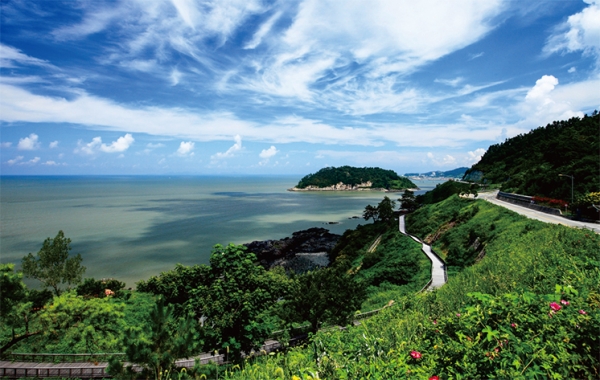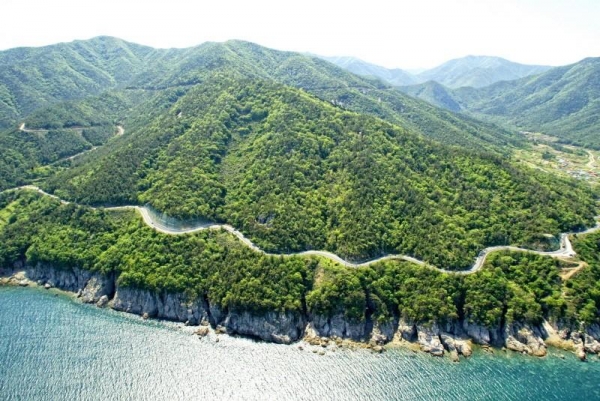"I fell in love with Korean stamps in 2017. When I first came to Korea from Costa Rica as a college freshman in 2010, I knew little about Korean history, people or tourist spots. While a student, I attended a few lectures on the nation's history and culture but didn't remember much from them.
A few years after graduation, I went to a post office to send a letter to a friend. I bought a postage stamp from the commemorative series "Beautiful Korea Definitive Stamps" featuring nine domestic landmarks including Dongbaekseom Island in Busan, Namdaemun (Sungnyemun) Gate in Seoul and Hwaseong Fortress in Suwon, Gyeonggi-do Province.
Even a tiny stamp holds a lot of information on Korea, I thought. So I decided to learn more about the country through stamps and eventually started collecting those displaying landmarks and people. This series is my introduction to Korean history and culture through stamps issued by the Korea Post."

The Korea Post on July 15 released a commemorative stamp series under the theme of "coastal roads" featuring Baeksu Costal Road in Yeongwang-gun County, Jeollanam-do Province; Heonhwa-ro Road in Gangneung, Gangwon-do Province; Sinchang Windmill Coastal Road on Jeju Island; and Mulmi Coastal Road in Namhae, Gyeongsangnam-do Province. The four roads offer gorgeous views of the country's coasts.
The Korean Peninsula is in the northeastern section of the Eurasian continent. As the nation's three sides are connected to the sea -- east, west and south – travelers can enjoy beautiful scenery in many parts. Jeju Island, one of Korea's best-known tourism destinations, has many coastal roads with fantastic sea views.
Such roads are popular for going on enjoyable drives featuring scenic views by car. As a natural social distancing measure, driving is a great way to enjoy leisure time amid the COVID-19 pandemic.
Park Jong-seok, head of the Postal Service Group at the Korea Post, said, "It is not easy to travel not only even within the country these days due to the prolonged COVID-19 pandemic. We hope that this commemorative stamp featuring Korea’s beautiful coastal roads stretching along nature gives you the delight of going on a trip, albeit vicariously."
The following are the four roads featured in this series.
Baeksu Coastal Road in Yeongwang-gun County

Baeksu Costal Road in Yeongwang-gun County, Jeollanam-do Province, is an 18.4 kilometer-long coastal road along the Yellow Sea, connecting Giryong-ri, the birthplace of Won Buddhism, Gusu-ri, Daesin-ri and Seokgumi Village in Baegam-ri.
While driving along the road, known for beautiful sunset glow, you can enjoy a panoramic view of the sunset inside the car. There are eight parking lots between Baegam-ri and Gusu-ri where you can drop by to appreciate the ocean view. This road was listed as one of the 100 beautiful roads in Korea announced by the Ministry of Land and Transport and Maritime Affairs, formerly the Ministry of Land and Transport and Maritime Affairs, in 2006. In 2011, it won the top prize in the first landscape award of the Republic of Korea.
Heonhwa-ro Road in Gangneung

Heonhwa-ro Road in Gangneung, Gangwon-do Province, is located right next to the sea and known for having one of the top drives along the East Sea. The road connects Geumjin Beach in Gangneung and Jeongdongjin Port. Jeongdongjin is located to the north of the road while Okgye Beach is in the south.
This road has an inland section from Geumjin, Okgye-myeon, and Simgok Port, and its highlight is the 2.4-km-long part from Geumjin Beach via Simgok Port to Jeongdongjin. Thanks to small guardrails, people can enjoy the deep sea of Gangwon-do inside the car.
The name "Heonhwa" originates from a myth in the historical text Samguk Yusa (Memorabilia of The Three Kingdoms) because its scenery is quite similar to that of the background of the myth "Heonhwaga," which literally means "song of offering flowers." Surfers began to gather here a few years ago, prompting the opening of surfing schools, accommodations and cafes.
Sinchang Windmill Coastal Road on Jeju Island

The 2-km Sinchang Windmill Coastal Road on Jeju Island is located in the village of Sinchang-ri, Hangyeong-myeon Township, on the island's western end. Windmills stand in line along the beach, and the curvy road features a scenic view decorated with while windmills, emerald blue sea and Chagwido Island from a distance. This road also offers opportunities for unique experiential activities like an ocean walk trail for an eco-tour highlighted by a saw-edged, perch-shaped work of installation art, a place for traditional Jeju-style fishing and rest areas.
Mulmi Coastal Road in Namhae-gun County

Namhae-gun County is composed of two islands: Namhaedo in the south of the Korean Peninsula and Changseondo. In 1973, Namhaedo was connected to the mainland with the completion of Namhae Bridge in 1973. In 1980, Changseon Bridge was built to connect both islands. In 2003. Changseondo was connected to the city of Sacheon, Gyeongsangnam-do Province, through the Changseon-Samcheonpo Bridge. Namhaedo is the country's fourth-largest island after Jeju, Geojedo and Jindo.
Mulmi Coastal Road can be found after crossing the Changseon-Samcheonpo Bridge, the third bridge connecting Namhaedo to the mainland. This 20-km road connects the villages of Mulgeon-ri in Samdong-myeon Township and Mijo-ri in Mijo-myeon Township. The first syllables of both Mulgeon-ri and Mijo-ri are how the name "Mulmi" came about.
This road is also nicknamed a "silk road that embraces Hallyeohaesang National Park." A bird's-eye view shows why the road has one of the county's top 12 scenic views. The curvy path offers the chance to relish the ocean view embroidered with flowers, foliage leaves, rocks of various shapes and the beautiful blue sea. The observatory in the middle of the road also offers spectacular views harmonized with the deep sea and a mountain.
| How to buy stamps Stamps in the commemorative series "Coastal Landscape Roads" can be purchased at select post offices nationwide and the Korea Postage Stamp Museum or through the official website (https://service.epost.go.kr/stamp.RetrievePostagGoodsList.postal) (Korean). |
For more information: Korea.net


